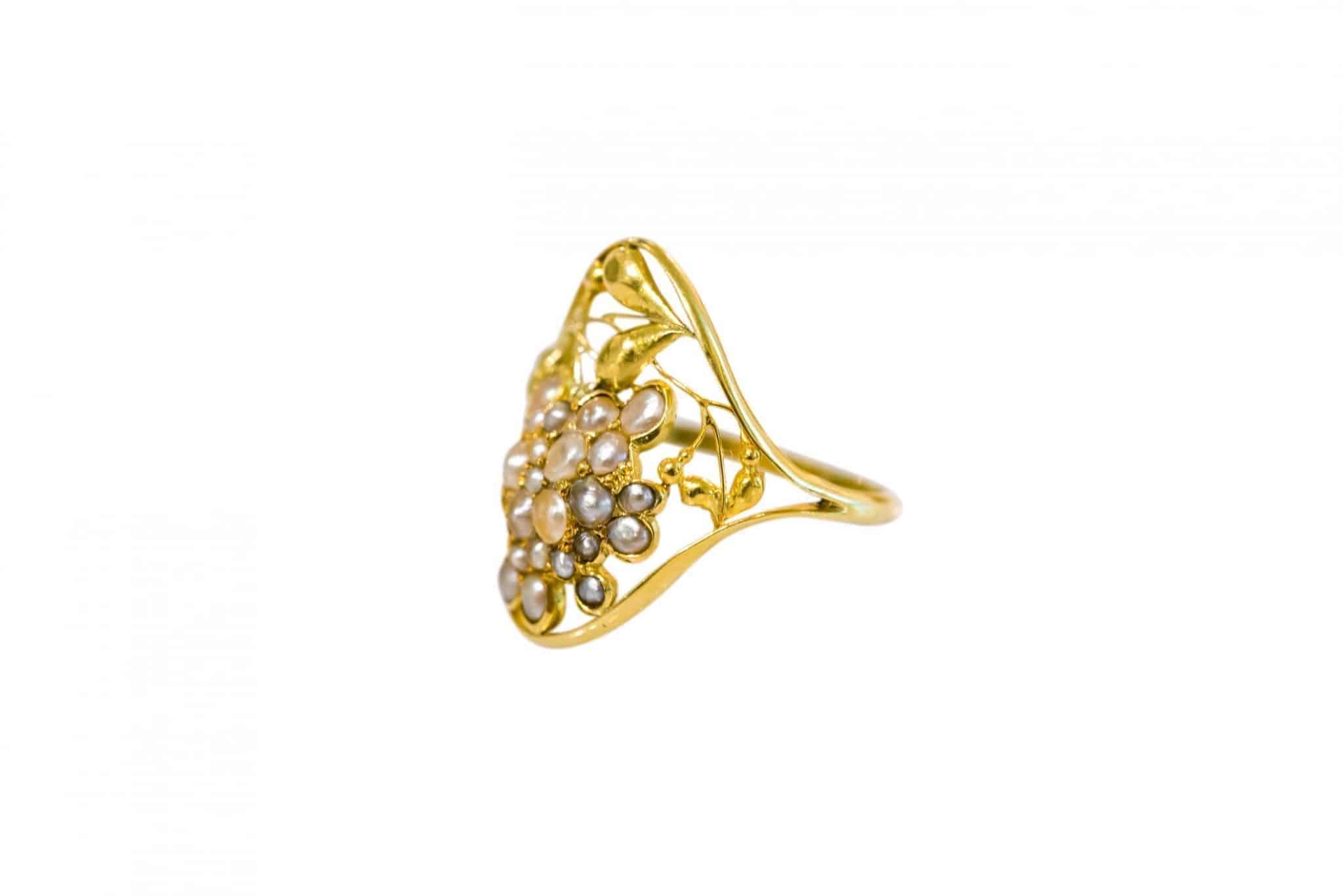Ring Josef Hoffmann Wiener Werkstatte 1912
Ring with freshwater pearls Josef Hoffmann Wiener Werkstatte 1912 unique piece
Description
The German journalist Josef August Lux published the following passages when he examined the jewellery of the Wiener Werkstatte: “What cannot be found in most jewellers can astonishingly be discovered at the Wiener Werkstatte: A true gold- and silversmiths craftsmanship,…” and “The works of the Wiener Werkstatte show riches that have been concealed inside the material, a treasure that had to be raised.” The enthusiasm of the journalist, author and art critic Josef August Lux can almost be felt while reading these lines. Jewellery pieces of the Wiener Werkstatte are among the most expensive objects of the Wiener Jugendstil and are highly sought after and asked for. Rings in particular have an exceptional position. Few preserved examples are exhibited in museums nowadays, a higher number remains in private collections. In addition, there were only a small number of copies produced of this type of jewellery; the archive of the Wiener Werkstatte in the Museum for applied Arts Vienna impressively shows this fact: only 69 rings are displayed via photographs designed by Josef Hoffmann.
Artist
Josef Hoffmann (Brtnice 1870 - 1956 Vienna), co-founder of the Viennese Secession and of the Wiener Werkstätte, was an extremely productive and versatile architect and designer. Throughout his career he experimented with various forms, techniques and materials. In his designs, he was striving for a strong reduction of the form to the essential and was a pioneer of geometric Jugendstil. This is how his characteristic geometric style was established. The scope of his designs ranges from buildings and entire interiors, following the concept of the “Gesamtkunstwerk” (total work of art), all the way to small details of everyday life. One of his most significant works is the Palais Stoclet in Brussels, a Gesamtkunstwerk which he executed for a wealthy entrepreneur between 1905 and 1911 in collaboration with, among others, Gustav Klimt and Koloman Moser.
Execution
Wiener Werkstatte 1903 - 1932 The Wiener Werkstatte was a production community founded on the model of the Arts and Crafts movement, which aimed to provide a platform for artistically designed and high quality crafts. Or, as G. Fahr-Becker puts it "...it was a workshop that gathered many, a work of art as the result of all the arts." Founded in 1903 by Josef Hoffmann, Koloman Moser and industrialist Fritz Waerndorfer, the Wiener Werkstatte (WW) initially produced and distributed only metal objects. The range was subsequently rapidly expanded to include furniture, furnishings, textiles, jewellery, accessories made of ceramics and glass, leather, etc. The wide range of products was sold in the company's own business premises in Vienna and, for a time, also in branches in Zurich and New York. The founding fathers and artistic directors J. Hoffmann and K. Moser originally pursued the ideal of artistic penetration of all areas of life in the sense of the Gesamtkunstwerk (total work of art). This radical aspiration could only be realized in a few projects, which were commissioned primarily by upper-class patrons. Impressive examples of this are the Palais Stoclet in Brussels or the Villa Skywa-Primavesi in Vienna. In its early years, the company was still committed to a strict geometric style, but this functionalism was soon expanded to include more pleasing forms. As a representative of a more decorative line, we should mention Dagobert Peche, who with his playful, imaginative ornamentation contributed designs for all divisions of WW. An important creative contribution, especially in the decorative sections of the WW, was made by the female artists from around 1915. The best known would probably be the ceramic artists Vally Wieselthier and Gudrun Baudisch. The significance of many of these female designers has only been duly appreciated in recent years*. The increasingly difficult economic environment after World War I led to the liquidation of the WW in 1932. Gabriele Fahr-Becker writes: "The financial difficulties which the Wiener Werkstatte had to face during its existence were not primarily the result of economic ignorance, but were based on the fact that the broad public could not be reached as buyers" (G. Fahr-Becker, Wiener Werkstätte, Taschen 1994, p. 12). Beyond the relatively short period of its existence, the Wiener Werkstatte exerted a lasting influence. Arts and crafts as well as applied arts were decisively revalued and a whole generation of architects, artists and designers were influenced by the artistic will of their founding fathers. *Bib.: C. Thun-Hohenstein, A.-K. Rossberg, E. Schmuttermeier (ed.), Die Frauen der Wiener Werkstatte (The Women of the Wiener Werkstatte), exhibition catalog Museum of Applied Arts Vienna, Wien 2020
Inquiry
By submitting the inquiry form, you agree to the use of your data for this inquiry. Privacy Policy


















